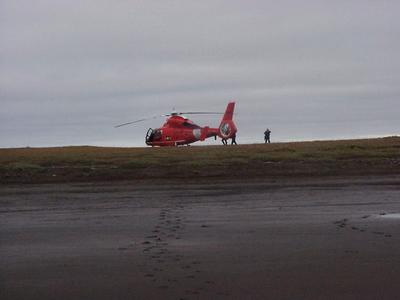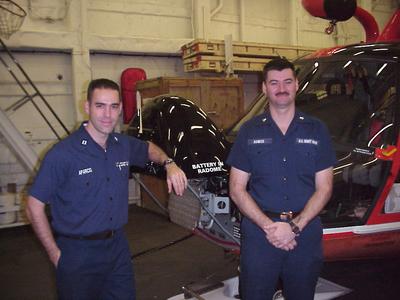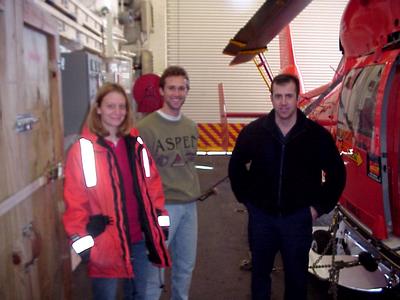
|
|
21 August, 2002
What a busy and exciting day! We started our last station early this
morning, so that meant that the benthic work came about 9:30. Although the
van Veen came up with a lot of sand and gravel, Jackie decided to try the
Haps core anyway. The cores were short (low mud) but with good overlying
water, so it was a success! As we were sectioning our last two cores of the
trip, an announcement was piped throughout the ship, "Attention all hands,
the sun is available for viewing on the port side!" Indeed the sun had come
out for the first time in more days than I can remember. It was great to
see the sun and the open blue ocean again. In addition to the excitement of
the sun and our last station, I found out that I would be going on a
helicopter trip later in the day! Laura Belicka and Karl Kaiser (see my
journal from August 1) needed to collect running river water and the
surrounding mud. They had been waiting for the right set of circumstances
(good weather, close enough to a river and a place to land, available
science time), and today was perfect!
At 1400 (2 o'clock), we all met in the helicopter hanger for our safety
briefing with AVT2 (Avionics Technician) Brandon Cheramie who told us about
the mustang suits and head gear we would wear as well as the proper
procedures for entering the helicopter and buckling the five point seat
belts. AVT2 Cheramie told us that his job consists of working as a
technician to conduct maintenance and weekly inspections when the
helicopters are not flying. There are actually four aircraft mechanics on
board the Healy, less than half the usual number for an icebreaker. AVT2
Tom Agness told me that, in addition to their other duties, all the
mechanics on board serve as aircrew members during flights. As crewmembers,
they operate the hoist system during rescue operations, and conduct
passenger briefings. They are also prepared to fight cabin fires if needed,
and to provide medical attention when necessary. Later, at 1600 (4
o'clock), we all met on the bridge for a flight briefing. The Captain, the
pilots and several officers were on hand to hear all the information related
to the proposed trip. We were reminded that we should be in the helicopter
hanger when the announcement for Flight Con 1 (Flight Condition 1) was
piped. After the briefing, I had a chance to talk with our two pilots, LTJG
Damon Williams and LT Michael Platt to learn a little bit about their work
on board. Note: I later spoke with the third pilot on board, LT Marc
Aparicio who told me that most icebreakers carry four pilots.
The Aviation Detachment on board the Healy consists of three pilots and four
mechanics. It's called a detachment because the helicopters are not a part
of the ship. They are based in Mobile, Alabama and fly to icebreakers
whenever and wherever needed. Before the Healy returns to Seattle in
October, the pilots will fly the helicopters back to Mobile. It will take
them about four days if they do three flights each day. One flight uses a
tank of gas and goes approximately 200 - 300 miles. Because Mobile is a
large training facility, the pilots will be busy until their next ship tour.
Although the helicopters and the pilots are a "detachment," they become the
Aviation Department when on board.
LT Platt was the pilot who talked with the students from the Anvil City
Science Academy who toured the ship when we were in Nome (see my journal
from July 16). He has been in the Coast Guard for twelve years and has been
a pilot since 1995. He was on the Healy for the Arctic East trip in 2001
when the Healy made it to the North Pole. He really enjoyed that trip and
the spring SBI cruise because he got to do so much flying. On the spring
SBI cruise, he was doing ice reconnaissance almost daily to try to find the
best route for the ship. For him, the best part of his job is the
challenge. Few Coast Guard pilots have the opportunity to fly Arctic
missions! LTJG Damon Williams has been in the Coast Guard for four and a
half years, but he has been a pilot since 1991. He came on board the Healy
in April of this year. He loves the novelty of operating off a ship and the
excitement of operating successfully far from support mechanisms. Both
pilots stressed that safety is everyone's top priority. For every hour of
flying time, seven hours of maintenance are required. Any pilot who flies
for more than six hours must have a minimum of ten hours off, and the crew's
mission log can't go beyond 12 hours. Although they are sometimes kidded
about their duty hours, everyone knows that safety is the key, and a rested
pilot is better than a tired one!
Prior to boarding, AMT1 Rich Lazaro gave us our mustang suits and
demonstrated the life vests that we wore around our waists. He also
provided earplugs to use under our headgear. Once we boarded the
helicopter, we sat while the pilots ran through an extensive checklist
before taking off. We flew approximately 500 feet above the water at a
speed of 120 knots. After passing over the tiny settlement of Point Lay, we
reached the Kokolik River. Once we found a solid spot for landing, AMTC
(Aviation Maintenance Technician Chief) Mark Cummings helped us unload our
gear. Laura and Karl headed for the river to collect their samples while
LTJG Williams brought out a bear rifle as a safeguard against polar bears.
Karl waded into the river while Laura collected mud from the edge. She was
so excited when she found peat a little way down in the sediments! Once
Karl and Laura were done, we headed back to the helicopter and our trip
"home" to the Healy. It's an amazing experience to see nothing but ocean
and suddenly spot a dot on the horizon. It's even more amazing to circle
the Healy and then land on the small helicopter pad near the stern of the
ship. Once we landed, the "ground" crew helped us unload and then they
secured the helicopter. Each time the helicopters take off, at least
seventeen crewmembers are available for support and in case of an emergency.
They include eight line crew for tie down and secondary fire party duty, two
for fire rescue, the remaining four in the aviation detachment, the HCO
(Helicopter Control Officer) in the HCO shack above the helicopter deck, the
LSO (Landing Safety Officer) on deck, and the XO (Executive Officer) on the
bridge. There is no question that safety is a top priority!

<> The helicopter made an impressive sight on the Alaskan tundra.

<> AMT1 Rich Lazaro gave us our mustang suits and demonstrated the use of the life vests we all wore around our waists.

<> Me, Karl Kaiser and Laura Belicka - all ready to go!

<> Left to right are LT Michael Platt, AMTC Mark Cummings, and LTJG Damon Williams. LT Platt and LTJG Williams were our pilots and AMTC Cummings was our crewmember for the flight to the Kokolik River.

<> The USCGC Healy carries a small Aviation Detachment of three pilots and four aviation mechanics. Most icebreakers carry four pilots and eight - ten mechanics. On the left is LT Marc Aparicio, one of the pilots, and on the right is AVT2 Tom Agness, an Avionics Technician.

<> AVT2 (Avionics Technician) Brandon Cheramie gave us our pre-trip safety briefing.

<> Laura sampled mud and peat from the edge of the Kokolik River.
Contact the TEA in the field at
.
If you cannot connect through your browser, copy the
TEA's e-mail address in the "To:" line of
your favorite e-mail package.
|
